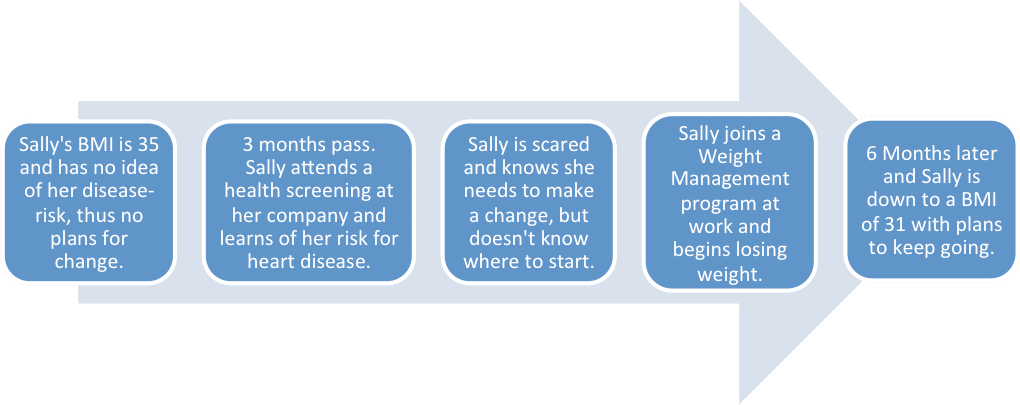7 Best Kept Secrets to Motivating Your Employees In Your Wellness Program
By Jaime Kennedy, MPH
Published October 22, 2014

Having trouble motivating your employees to participate in your wellness program? Welcome to the club! This seems to be the trend when it comes to personal health; it’s unfortunately always the last on the priority list.
To address this issue, I need to (briefly) introduce you to my favorite model that changed our line of thinking with motivating others to focus on their health: The Transtheoretical Model (TTM). The TTM was developed in 1977 by James Prochaska & colleagues, and seeks to conceptualize the process of intentional behavior change.
Also known as the “Stages of Change.” It helps to explain that people move through a series of stages when modifying behavior. Those “stages” go a little something like this:
- Precontemplation: People who do not intend to take action in the foreseeable future.
- Contemplation: People who intend to change in the next 6 months.
- Preparation: Stage in which people intend to take action in the immediate future, usually measured as the next month.
- Action: The stage in which people have made behavior modifications in their life, within the last 6 months.
- Maintenance: Those individuals who have made the change, and are actively working to prevent a relapse.
With that said, you will discover a range of employee participants, some who are excited about the impending wellness initiative and some who just, well, aren’t. Those who are excited are most likely in the Preparation, Action or Maintenance stage. Those who are in the Precontemplation and Contemplation stage may not engage, at least in the beginning.
Let me give you a real-life example of Sally and her battle with weight-management:
Sally didn’t enter the contemplation stage until she had the “behavior change moment,” which served as an onsite screening, in this example. Then she began to take the wellness program (and her health) seriously.
Our 7 Best Kept Secrets For Motivating Your Employees
Summarized below are our 7 best kept secrets for motivating your employees no matter what stage of change they are in, and hopefully helping them to find that “behavior change moment” as well:
- Understand the KEY factors that influence people’s health behaviors. Those factors being: time (look for the best time of day and reduce length of activity), access (onsite & during work hours are the best), knowledge (explain the benefits of participating), program costs (offered at a reduced rate is best), and choosing the right incentives (see #7 for more on this topic…);
- Goal Setting. Setting goals has been shown to lead to better participation and more people making a strong commitment. Having something concrete to aim for increases the likelihood people will stick with the program;
- Buddy Systems or Team Goals. The social aspects of improving one’s health cannot be underestimated. Many studies point to tight social groups being the backbone for a successful campaign because each individual has a commitment to something bigger than themselves; plus, it’s just more fun for most people. Consider building your program around teams or partners;
- Offer personal, team and company-wide recognition when employees accomplish major wellness goals or produce exceptional work. Encourage managers to recognize individual good health on a consistent basis. Recognizing employees on all levels of the company, not just management or long-time employees, is important in keeping motivation and morale high;
- Utilize the strength of power. Share Management’s excitement and expectations for the future of the employee wellness program through effective communication from the top down. Once employees see and feel visible commitment from their superiors, the culture of health will become more prevalent. Which leads me to my next secret;
- Build a Culture of Health. Easier said than done, huh? This is something that can take months and even years for some. However, it can be accomplished! Once the culture of health is embraced; employees will begin bragging about their healthy lunches, how many miles they walked last week, and a new recipe they just tried; and
- Incentives: (I told you I would come back to this one) Incentives are often helpful in maintaining or raising interest. Incentives such as cash or health insurance rebates have proven to be the strongest motivators for employee participation.
I hope you found this post helpful with engaging your employees in your program! If you have any success stories or tips to share, please send them to me – I would love to hear them!
Jaime Kennedy is an #EmployeeBenefits fanatic with a passion for holistic well-being. She developed her niche in Employee Benefits Consulting after earning a Masters of Public Health in 2012. Since joining The Bailey Group team, Jaime has become a strategic asset to our client’s by proving creative strategy designs that focus not only on cost-containment, but go further to look at how we can use benefits to propel their business forward. Jaime especially loves her family, church, Eco-living, and making green smoothies a part of her daily routine.





